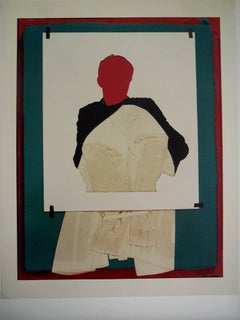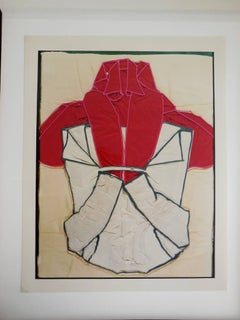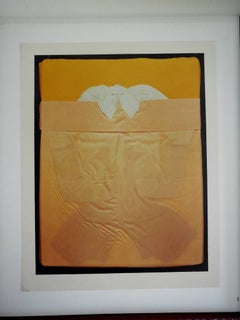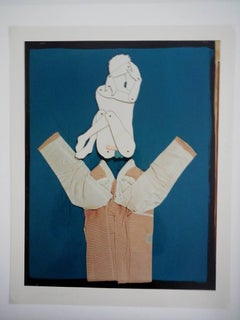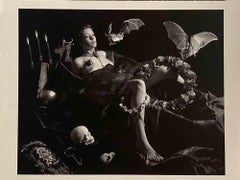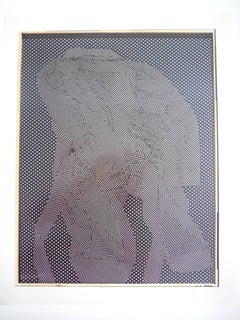Harry Bowers Photography
to
10
10
10
Overall Height
to
Overall Width
to
1
1
6
5
4
4
3
3
3
2
2
2
1
1
1
1
1
10
10
10
6,976
3,359
2,513
1,212
9
9
4
Artist: Harry Bowers
Large Harry Bowers Vintage C Print Photograph From Ten Photographs Fashion Photo
By Harry Bowers
Located in Surfside, FL
HARRY BOWERS
T E N P H O T O G R A P H S
I DON'T LOOK FOR PHOTOGRAPHS I INVENT THEM
I recall my first meeting with Harry Bowers in California a few years ago. As he produc...
Category
1980s Arte Povera Harry Bowers Photography
Materials
Photographic Paper, C Print
Rare Large Harry Bowers Vintage C Print Photograph Ten Photographs Fashion Photo
By Harry Bowers
Located in Surfside, FL
HARRY BOWERS
T E N P H O T O G R A P H S
I DON'T LOOK FOR PHOTOGRAPHS I INVENT THEM
I recall my first meeting with Harry Bowers in California a few years ago. As he produced his large-scale prints, I was at first flabbergasted, not only by their size, but by their seamless perfection. Technique appeared to be everything but then technique as technique simply vanished. After the first moment, technique was no longer an issue, but rather a passageway to the imagery.
Suffice it to say about Harry Bowers' working style that he is an obsessive man. Trained as an engineer, he has turned that discipline to art. His lenses, equipment and darkroom, much of it exactingly manufactured by himself to answer certain needs, serve the desire of the artist to take photographic technique to its ultimate perfection in invisibility and transparency. I respect obsession in art, and particularly in photography, because obsession in photography passes beyond the easy, middle ground of image making to a more demanding, more difficult, yet more rewarding end. Bowers' obsession is to eliminate "photography as technique." No grain, no decisive moments, no journalism, or, seemingly, direct autobiographical endeavors appear in his work.
Bowers is an artist of synthesis who controls his environment if only in the studio exactly to his liking. The images he creates are formal structures, saucy stories on occasion, which may offer hints of a darker, more frightening sexuality, but what you see is the end product of an experiment in which nothing save the original insight perhaps is left to chance.
We seem fascinated with the idea of replication of reality in art. Popular painting frequently reproduces a scene "with the accuracy of a photograph," and photographs may "make you feel as though you were right there." The very invisibility of the photographic medium is important to Bowers, in that it allows him to maneuver his subject matter without concern for rendering it in an obvious art medium which would interfere with the nature of the materials he uses. The formal subtleties of Bowers' recent work are as delicious and ambiguous in their interrelationships as the best Cubist collages, yet while those collages always suggest their parts through edge and texture, these photographs present a structure through a surface purity.
"I follow fashion. I have closets literally full of clothes. I am a full-blown Comme des Garçons and Prada freak. I love clothes themselves as objects, and I also love the glossies – my love of fashion is how I discovered Wallpaper magazine" Bowers' earlier works, for example, the Skirts I Have Known series, were formed of bits of clothing belonging to Bowers and his wife or found at local thrift shops. These works fused an elegance of pattern and texture, reminiscent of Miriam Shapiro...
Category
1980s Harry Bowers Photography
Materials
Photographic Paper
Large Harry Bowers Vintage C Print Photograph From Ten Photographs Fashion Photo
By Harry Bowers
Located in Surfside, FL
HARRY BOWERS
T E N P H O T O G R A P H S
I DON'T LOOK FOR PHOTOGRAPHS I INVENT THEM
I recall my first meeting with Harry Bowers in California a few years ago. As he produced his large-scale prints, I was at first flabbergasted, not only by their size, but by their seamless perfection. Technique appeared to be everything but then technique as technique simply vanished. After the first moment, technique was no longer an issue, but rather a passageway to the imagery.
Suffice it to say about Harry Bowers' working style that he is an obsessive man. Trained as an engineer, he has turned that discipline to art. His lenses, equipment and darkroom, much of it exactingly manufactured by himself to answer certain needs, serve the desire of the artist to take photographic technique to its ultimate perfection in invisibility and transparency. I respect obsession in art, and particularly in photography, because obsession in photography passes beyond the easy, middle ground of image making to a more demanding, more difficult, yet more rewarding end. Bowers' obsession is to eliminate "photography as technique." No grain, no decisive moments, no journalism, or, seemingly, direct autobiographical endeavors appear in his work.
Bowers is an artist of synthesis who controls his environment if only in the studio exactly to his liking. The images he creates are formal structures, saucy stories on occasion, which may offer hints of a darker, more frightening sexuality, but what you see is the end product of an experiment in which nothing save the original insight perhaps is left to chance.
We seem fascinated with the idea of replication of reality in art. Popular painting frequently reproduces a scene "with the accuracy of a photograph," and photographs may "make you feel as though you were right there." The very invisibility of the photographic medium is important to Bowers, in that it allows him to maneuver his subject matter without concern for rendering it in an obvious art medium which would interfere with the nature of the materials he uses. The formal subtleties of Bowers' recent work are as delicious and ambiguous in their interrelationships as the best Cubist collages, yet while those collages always suggest their parts through edge and texture, these photographs present a structure through a surface purity.
Bowers' earlier works, for example, the Skirts I Have Known series, were formed of bits of clothing belonging to Bowers and his wife or found at local thrift shops. These works fused an elegance of pattern and texture, reminiscent of Miriam Shapiro...
Category
1980s Harry Bowers Photography
Materials
Photographic Paper
Rare Large Harry Bowers Vintage C Print Photograph Ten Photographs Fashion Photo
By Harry Bowers
Located in Surfside, FL
HARRY BOWERS
T E N P H O T O G R A P H S
I DON'T LOOK FOR PHOTOGRAPHS I INVENT THEM
I recall my first meeting with Harry Bowers in California a few years ago. As he produc...
Category
1980s Pop Art Harry Bowers Photography
Materials
Photographic Paper
Large Harry Bowers Vintage C Print Photograph From Ten Photographs Fashion Photo
By Harry Bowers
Located in Surfside, FL
HARRY BOWERS
T E N P H O T O G R A P H S
I DON'T LOOK FOR PHOTOGRAPHS I INVENT THEM
I recall my first meeting with Harry Bowers in California a few years ago. As he produced his large-scale prints, I was at first flabbergasted, not only by their size, but by their seamless perfection. Technique appeared to be everything but then technique as technique simply vanished. After the first moment, technique was no longer an issue, but rather a passageway to the imagery.
Suffice it to say about Harry Bowers' working style that he is an obsessive man. Trained as an engineer, he has turned that discipline to art. His lenses, equipment and darkroom, much of it exactingly manufactured by himself to answer certain needs, serve the desire of the artist to take photographic technique to its ultimate perfection in invisibility and transparency. I respect obsession in art, and particularly in photography, because obsession in photography passes beyond the easy, middle ground of image making to a more demanding, more difficult, yet more rewarding end. Bowers' obsession is to eliminate "photography as technique." No grain, no decisive moments, no journalism, or, seemingly, direct autobiographical endeavors appear in his work.
Bowers is an artist of synthesis who controls his environment if only in the studio exactly to his liking. The images he creates are formal structures, saucy stories on occasion, which may offer hints of a darker, more frightening sexuality, but what you see is the end product of an experiment in which nothing save the original insight perhaps is left to chance.
We seem fascinated with the idea of replication of reality in art. Popular painting frequently reproduces a scene "with the accuracy of a photograph," and photographs may "make you feel as though you were right there." The very invisibility of the photographic medium is important to Bowers, in that it allows him to maneuver his subject matter without concern for rendering it in an obvious art medium which would interfere with the nature of the materials he uses. The formal subtleties of Bowers' recent work are as delicious and ambiguous in their interrelationships as the best Cubist collages, yet while those collages always suggest their parts through edge and texture, these photographs present a structure through a surface purity.
Bowers' earlier works, for example, the Skirts I Have Known series, were formed of bits of clothing belonging to Bowers and his wife or found at local thrift shops. These works fused an elegance of pattern and texture, reminiscent of Miriam Shapiro...
Category
1980s Arte Povera Harry Bowers Photography
Materials
C Print, Photographic Paper
Large Harry Bowers Vintage C Print Photograph From Ten Photographs Fashion Photo
By Harry Bowers
Located in Surfside, FL
HARRY BOWERS
T E N P H O T O G R A P H S
I DON'T LOOK FOR PHOTOGRAPHS I INVENT THEM
I recall my first meeting with Harry Bowers in California a few years ago. As he produced his large-scale prints, I was at first flabbergasted, not only by their size, but by their seamless perfection. Technique appeared to be everything but then technique as technique simply vanished. After the first moment, technique was no longer an issue, but rather a passageway to the imagery.
Suffice it to say about Harry Bowers' working style that he is an obsessive man. Trained as an engineer, he has turned that discipline to art. His lenses, equipment and darkroom, much of it exactingly manufactured by himself to answer certain needs, serve the desire of the artist to take photographic technique to its ultimate perfection in invisibility and transparency. I respect obsession in art, and particularly in photography, because obsession in photography passes beyond the easy, middle ground of image making to a more demanding, more difficult, yet more rewarding end. Bowers' obsession is to eliminate "photography as technique." No grain, no decisive moments, no journalism, or, seemingly, direct autobiographical endeavors appear in his work.
Bowers is an artist of synthesis who controls his environment if only in the studio exactly to his liking. The images he creates are formal structures, saucy stories on occasion, which may offer hints of a darker, more frightening sexuality, but what you see is the end product of an experiment in which nothing save the original insight perhaps is left to chance.
We seem fascinated with the idea of replication of reality in art. Popular painting frequently reproduces a scene "with the accuracy of a photograph," and photographs may "make you feel as though you were right there." The very invisibility of the photographic medium is important to Bowers, in that it allows him to maneuver his subject matter without concern for rendering it in an obvious art medium which would interfere with the nature of the materials he uses. The formal subtleties of Bowers' recent work are as delicious and ambiguous in their interrelationships as the best Cubist collages, yet while those collages always suggest their parts through edge and texture, these photographs present a structure through a surface purity.
Bowers' earlier works, for example, the Skirts I Have Known series, were formed of bits of clothing belonging to Bowers and his wife or found at local thrift shops. These works fused an elegance of pattern and texture, reminiscent of Miriam Shapiro...
Category
1980s Arte Povera Harry Bowers Photography
Materials
Photographic Paper
Rare Harry Bowers Vintage C Print Photograph From Ten Photographs Fashion Photo
By Harry Bowers
Located in Surfside, FL
HARRY BOWERS
T E N P H O T O G R A P H S
I DON'T LOOK FOR PHOTOGRAPHS I INVENT THEM
I recall my first meeting with Harry Bowers in California a few years ago. As he produced his large-scale prints, I was at first flabbergasted, not only by their size, but by their seamless perfection. Technique appeared to be everything but then technique as technique simply vanished. After the first moment, technique was no longer an issue, but rather a passageway to the imagery.
Suffice it to say about Harry Bowers' working style that he is an obsessive man. Trained as an engineer, he has turned that discipline to art. His lenses, equipment and darkroom, much of it exactingly manufactured by himself to answer certain needs, serve the desire of the artist to take photographic technique to its ultimate perfection in invisibility and transparency. I respect obsession in art, and particularly in photography, because obsession in photography passes beyond the easy, middle ground of image making to a more demanding, more difficult, yet more rewarding end. Bowers' obsession is to eliminate "photography as technique." No grain, no decisive moments, no journalism, or, seemingly, direct autobiographical endeavors appear in his work.
Bowers is an artist of synthesis who controls his environment if only in the studio exactly to his liking. The images he creates are formal structures, saucy stories on occasion, which may offer hints of a darker, more frightening sexuality, but what you see is the end product of an experiment in which nothing save the original insight perhaps is left to chance.
We seem fascinated with the idea of replication of reality in art. Popular painting frequently reproduces a scene "with the accuracy of a photograph," and photographs may "make you feel as though you were right there." The very invisibility of the photographic medium is important to Bowers, in that it allows him to maneuver his subject matter without concern for rendering it in an obvious art medium which would interfere with the nature of the materials he uses. The formal subtleties of Bowers' recent work are as delicious and ambiguous in their interrelationships as the best Cubist collages, yet while those collages always suggest their parts through edge and texture, these photographs present a structure through a surface purity.
Bowers' earlier works, for example, the Skirts I Have Known series, were formed of bits of clothing belonging to Bowers and his wife or found at local thrift shops. These works fused an elegance of pattern and texture, reminiscent of Miriam Shapiro...
Category
1980s Harry Bowers Photography
Materials
Photographic Paper
Large Harry Bowers Vintage C Print Photograph From Ten Photographs Fashion Photo
By Harry Bowers
Located in Surfside, FL
HARRY BOWERS
T E N P H O T O G R A P H S
I DON'T LOOK FOR PHOTOGRAPHS I INVENT THEM
I recall my first meeting with Harry Bowers in California a few years ago. As he produced his large-scale prints, I was at first flabbergasted, not only by their size, but by their seamless perfection. Technique appeared to be everything but then technique as technique simply vanished. After the first moment, technique was no longer an issue, but rather a passageway to the imagery.
Suffice it to say about Harry Bowers' working style that he is an obsessive man. Trained as an engineer, he has turned that discipline to art. His lenses, equipment and darkroom, much of it exactingly manufactured by himself to answer certain needs, serve the desire of the artist to take photographic technique to its ultimate perfection in invisibility and transparency. I respect obsession in art, and particularly in photography, because obsession in photography passes beyond the easy, middle ground of image making to a more demanding, more difficult, yet more rewarding end. Bowers' obsession is to eliminate "photography as technique." No grain, no decisive moments, no journalism, or, seemingly, direct autobiographical endeavors appear in his work.
Bowers is an artist of synthesis who controls his environment if only in the studio exactly to his liking. The images he creates are formal structures, saucy stories on occasion, which may offer hints of a darker, more frightening sexuality, but what you see is the end product of an experiment in which nothing save the original insight perhaps is left to chance.
We seem fascinated with the idea of replication of reality in art. Popular painting frequently reproduces a scene "with the accuracy of a photograph," and photographs may "make you feel as though you were right there." The very invisibility of the photographic medium is important to Bowers, in that it allows him to maneuver his subject matter without concern for rendering it in an obvious art medium which would interfere with the nature of the materials he uses. The formal subtleties of Bowers' recent work are as delicious and ambiguous in their interrelationships as the best Cubist collages, yet while those collages always suggest their parts through edge and texture, these photographs present a structure through a surface purity.
Bowers' earlier works, for example, the Skirts I Have Known series, were formed of bits of clothing belonging to Bowers and his wife or found at local thrift shops. These works fused an elegance of pattern and texture, reminiscent of Miriam Shapiro...
Category
1980s American Modern Harry Bowers Photography
Materials
C Print, Photographic Paper
Rare Harry Bowers Vintage C Print Photograph From Ten Photographs Fashion Shot
By Harry Bowers
Located in Surfside, FL
HARRY BOWERS
T E N P H O T O G R A P H S
I DON'T LOOK FOR PHOTOGRAPHS I INVENT THEM
I recall my first meeting with Harry Bowers in California a few years ago. As he produc...
Category
1980s 85 New Wave Harry Bowers Photography
Materials
C Print
Rare Harry Bowers Vintage C Print Photograph From Ten Photographs Fashion Photo
By Harry Bowers
Located in Surfside, FL
HARRY BOWERS
T E N P H O T O G R A P H S
I DON'T LOOK FOR PHOTOGRAPHS I INVENT THEM
I recall my first meeting with Harry Bowers in California a few years ago. As he produced his large-scale prints, I was at first flabbergasted, not only by their size, but by their seamless perfection. Technique appeared to be everything but then technique as technique simply vanished. After the first moment, technique was no longer an issue, but rather a passageway to the imagery.
Suffice it to say about Harry Bowers' working style that he is an obsessive man. Trained as an engineer, he has turned that discipline to art. His lenses, equipment and darkroom, much of it exactingly manufactured by himself to answer certain needs, serve the desire of the artist to take photographic technique to its ultimate perfection in invisibility and transparency. I respect obsession in art, and particularly in photography, because obsession in photography passes beyond the easy, middle ground of image making to a more demanding, more difficult, yet more rewarding end. Bowers' obsession is to eliminate "photography as technique." No grain, no decisive moments, no journalism, or, seemingly, direct autobiographical endeavors appear in his work.
Bowers is an artist of synthesis who controls his environment if only in the studio exactly to his liking. The images he creates are formal structures, saucy stories on occasion, which may offer hints of a darker, more frightening sexuality, but what you see is the end product of an experiment in which nothing save the original insight perhaps is left to chance.
We seem fascinated with the idea of replication of reality in art. Popular painting frequently reproduces a scene "with the accuracy of a photograph," and photographs may "make you feel as though you were right there." The very invisibility of the photographic medium is important to Bowers, in that it allows him to maneuver his subject matter without concern for rendering it in an obvious art medium which would interfere with the nature of the materials he uses. The formal subtleties of Bowers' recent work are as delicious and ambiguous in their interrelationships as the best Cubist collages, yet while those collages always suggest their parts through edge and texture, these photographs present a structure through a surface purity.
Bowers' earlier works, for example, the Skirts I Have Known series, were formed of bits of clothing belonging to Bowers and his wife or found at local thrift shops. These works fused an elegance of pattern and texture, reminiscent of Miriam Shapiro...
Category
1980s Harry Bowers Photography
Materials
Photographic Paper
Related Items
Blue Flowing Curved Shapes, Modern Mid-Century Print on Paper, Blues, Neutral
By Kind of Cyan
Located in Barcelona, ES
This is an exclusive handprinted unique cyanotype that takes its inspiration from mid-century modern style shapes.
It's made by layering paper cutouts and different exposures using ...
Category
2010s Modern Harry Bowers Photography
Materials
Photographic Film, Emulsion, Printer's Ink, Watercolor, Photographic Pap...
Vampire - Photograph by Plinio Martelli - 2000s
Located in Roma, IT
Vampire is an original photograph realized by Plinio Martelli in 2000s.
The artwork represents a vampire woman.
Excellent conditions. Hand-signed and...
Category
Early 2000s Contemporary Harry Bowers Photography
Materials
Photographic Paper
Burlesque Series, Delilah Right Red Hand I, The Whoopee Club, London
By Richard Heeps
Located in Cambridge, GB
Richard Heeps became well-known for his Burlesque Photography after he spent 2003 capturing performances in Britain & America. He spent a lot on time with his subjects on a number of...
Category
Early 2000s Contemporary Harry Bowers Photography
Materials
C Print, Photographic Paper, Color, Silver Gelatin
H 44.1 in W 33.47 in D 1.97 in
Burlesque Series, Martini Fan Dance XXII, Tease-O-Rama, Hollywood, Los Angeles
By Richard Heeps
Located in Cambridge, GB
Richard Heeps became well-known for his Burlesque Photography after he spent 2003 capturing performances in Britain & America. He spent a lot on time with his subjects on a number of...
Category
Early 2000s Contemporary Harry Bowers Photography
Materials
C Print, Photographic Paper, Color, Silver Gelatin
H 44.1 in W 33.47 in D 1.97 in
Andy Warhol, Photograph of Bruce Springsteen, 1978
By Andy Warhol
Located in Santa Monica, CA
Bruce Springsteen is an American rock musician known for his work with the E Street band. His breakthrough came in the mid-1970s and early 80s, when he gained notoriety for his energ...
Category
1980s Pop Art Harry Bowers Photography
Materials
Photographic Paper
Burlesque Series, Tease-O-Rama, Hollywood, Los Angeles
By Richard Heeps
Located in Cambridge, GB
Richard Heeps became well-known for his Burlesque Photography after he spent 2003 capturing performances in Britain & America. He spent a lot on time with his subjects on a number of...
Category
Early 2000s Contemporary Harry Bowers Photography
Materials
C Print, Photographic Paper, Color, Silver Gelatin
H 44.1 in W 33.47 in D 1.97 in
Arnold Schwarzenegger & Grace Jones at His Wedding
By Andy Warhol
Located in Santa Monica, CA
Illustrated in Contact Warhol: Photography Without End, edited by Peggy Phelan and Richard Meyer. An iconic book celebrating Warhol's most famous photogr...
Category
1980s Pop Art Harry Bowers Photography
Materials
Photographic Paper, Silver Gelatin
Burlesque Series, Boudoir III, Tease-O-Rama, Hollywood, Los Angeles
By Richard Heeps
Located in Cambridge, GB
Richard Heeps became well-known for his Burlesque Photography after he spent 2003 capturing performances in Britain & America. He spent a lot on time with his subjects on a number of...
Category
Early 2000s Contemporary Harry Bowers Photography
Materials
C Print, Photographic Paper, Color, Silver Gelatin
H 44.1 in W 33.47 in D 1.97 in
Portrait of Franca Marzi - Vintage Photo - 1960s
Located in Roma, IT
Vintage Photo.
The Italian Actress Franca Marzi posing in the photo studio.
Category
1960s Contemporary Harry Bowers Photography
Materials
Photographic Paper
Monica Vitti - Vintage Photo - 1960s
Located in Roma, IT
Monica Vitti is a vintage black and white photo of the italian actres, realized in 1960s.
L'agenzia Nazionale Stampa Associata (ANSA)
Monica Vitti is born in Rome on November 3, 1931. Admitted in 1950 to the Academy of Dramatic Art (where she will return in 1986 as a teacher), and graduated in 1953, she immediately tackles the scenes in L'avaro di Molière (1954), The island of the parrots of S. Tofano (1954), They founded a city of C. Meano (1954), Mother Courage and her children of B. Brecht (1954). Between 1956 and 1959 she also participated in television broadcasts and acted in numerous adaptations of famous theatrical texts. She made her film debut playing secondary parts in Laugh, Laugh, Laugh! by E. Anton, 1955; A mink coat by G. Pellegrini, 1956; Le dritte di M. Amendola, 1958. Dubbing actress of Il scido di M. Antonioni (1957), she meets the director who, after having directed her to the theater in I am a camera by J. Van Druten (1957) and in Secret Scandals by Antonioni and E. Bartolini (1957), he calls her as the protagonist in L'avventura (1960), a film with which V. is a leading actress. Always led by Antonioni, from now on she will play suffering characters who embody a profound crisis of feelings. Apart from a brief television parenthesis (a transposition of the short story The White Nights by F. Dostoevskij, directed by V. Cottafavi), La notte (1961), L'eclisse (1962) and Deserto rosso (1963) belong to a happy partnership with Antonioni (who will be revived episodically for the production of The Mystery of Oberwald [1980], a courageous experiment of intertwining cinema and electronic techniques, propitiated by the exhumation of a play by J. Cocteau, L'aigle à deux têtes). In the second half of the Sixties, however, the producers showed that they preferred her as an actress endowed with caricatural flair, fine humor, vitalistic exuberance, communicative immediacy; and audiences pay her a growing success, not always corresponding to the quality of her filmography or the variety of her interpretations, among which are the very convincing ones in Modesty Blaise...
Category
1960s Contemporary Harry Bowers Photography
Materials
Photographic Paper
The Italian Actress Paola Borboni - Vintage Photo -1980s
Located in Roma, IT
Vintage Photo.
The Italian Actress Paola Borboni.
Category
1980s Contemporary Harry Bowers Photography
Materials
Photographic Paper
Burlesque Series, Boudoir II, Tease-O-Rama, Hollywood, Los Angeles - Color Photo
By Richard Heeps
Located in Cambridge, GB
Richard Heeps became well-known for his Burlesque Photography after he spent 2003 capturing performances in Britain & America. He spent a lot on time with his subjects on a number of...
Category
Early 2000s Contemporary Harry Bowers Photography
Materials
C Print, Photographic Paper, Color, Silver Gelatin
H 33.47 in W 44.1 in D 1.97 in
Previously Available Items
Ten Photographs
By Harry Bowers
Located in Surfside, FL
HARRY BOWERS
T E N P H O T O G R A P H S
I DON'T LOOK FOR PHOTOGRAPHS I INVENT THEM
I recall my first meeting with Harry Bowers in California a few years ago. As he...
Category
1980s Harry Bowers Photography
Ten Photographs
By Harry Bowers
Located in Surfside, FL
HARRY BOWERS
T E N P H O T O G R A P H S
I DON'T LOOK FOR PHOTOGRAPHS I INVENT THEM
I recall my first meeting with Harry Bowers in California a few years ago. As he...
Category
1980s Harry Bowers Photography
Large Vintage Color Photograph C-Print Clothing Composition Signed
By Harry Bowers
Located in Surfside, FL
HARRY BOWERS
T E N P H O T O G R A P H S
I DON'T LOOK FOR PHOTOGRAPHS I INVENT THEM
I recall my first meeting with Harry Bowers in California a few years ago. As he produc...
Category
1980s American Modern Harry Bowers Photography
Materials
Photographic Paper, C Print
Rare Harry Bowers Vintage CPrint Photograph From Ten Photographs
By Harry Bowers
Located in Surfside, FL
HARRY BOWERS
T E N P H O T O G R A P H S
I DON'T LOOK FOR PHOTOGRAPHS I INVENT THEM
I recall my first meeting with Harry Bowers in California a few years ago. As he...
Category
1980s 85 New Wave Harry Bowers Photography
Materials
C Print
Ten Photographs
By Harry Bowers
Located in Surfside, FL
HARRY BOWERS
T E N P H O T O G R A P H S
I DON'T LOOK FOR PHOTOGRAPHS I INVENT THEM
I recall my first meeting with Harry Bowers in California a few years ago. As he...
Category
1980s Harry Bowers Photography
Ten Photographs
By Harry Bowers
Located in Surfside, FL
HARRY BOWERS
T E N P H O T O G R A P H S
I DON'T LOOK FOR PHOTOGRAPHS I INVENT THEM
I recall my first meeting with Harry Bowers in California a few years ago. As he...
Category
1980s Harry Bowers Photography
Ten Photographs
By Harry Bowers
Located in Surfside, FL
HARRY BOWERS
T E N P H O T O G R A P H S
I DON'T LOOK FOR PHOTOGRAPHS I INVENT THEM
I recall my first meeting with Harry Bowers in California a few years ago. As he...
Category
1980s Harry Bowers Photography
Ten Photographs
By Harry Bowers
Located in Surfside, FL
HARRY BOWERS
T E N P H O T O G R A P H S
I DON'T LOOK FOR PHOTOGRAPHS I INVENT THEM
I recall my first meeting with Harry Bowers in California a few years ago. As he...
Category
1980s Harry Bowers Photography
Ten Photographs
By Harry Bowers
Located in Surfside, FL
HARRY BOWERS
T E N P H O T O G R A P H S
I DON'T LOOK FOR PHOTOGRAPHS I INVENT THEM
I recall my first meeting with Harry Bowers in California a few years ago. As he...
Category
1980s Harry Bowers Photography
Ten Photographs
By Harry Bowers
Located in Surfside, FL
HARRY BOWERS
T E N P H O T O G R A P H S
I DON'T LOOK FOR PHOTOGRAPHS I INVENT THEM
I recall my first meeting with Harry Bowers in California a few years ago. As he...
Category
1980s Harry Bowers Photography
Harry Bowers photography for sale on 1stDibs.
Find a wide variety of authentic Harry Bowers photography available for sale on 1stDibs. You can also browse by medium to find art by Harry Bowers in paper, photographic paper, c print and more. Much of the original work by this artist or collective was created during the 1980s and is mostly associated with the modern style. Not every interior allows for large Harry Bowers photography, so small editions measuring 16 inches across are available. Customers who are interested in this artist might also find the work of Michael DeCamp, Bruce Cratsley, and Paul Garrin. Harry Bowers photography prices can differ depending upon medium, time period and other attributes. On 1stDibs, the price for these items starts at $1,200 and tops out at $1,200, while the average work can sell for $1,200.
